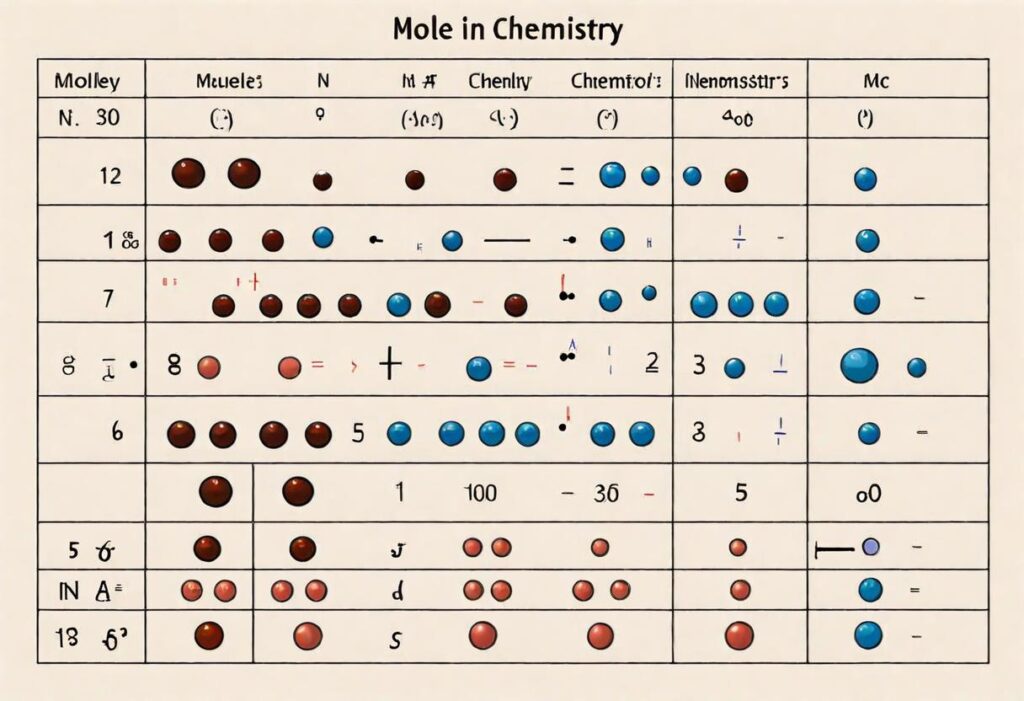Greeting to all the AP- Chemistry Students! In today’s class, we will cover the fundamental ideas of moles molar mass, and molar mass which are pivotal concerning the use of chemicals in practice. These concepts allow us to measure atoms and indeed, molecules, which are both countable and too tiny to get the number with a sensor that can count only larger things. So we can understand the microscopic world that surrounds us.

The discipline of Chemistry generally encompasses the manipulation of particles like that of atoms and molecules which are imaged to be extremely small. For example, a water molecule (H2O) has a size measured in terms of 0.00000000003m!!! It would be impossible to think of counting them, in this case, so chemists created a concept that would help make this easier.
The mole which is otherwise denoted by the symbol mol, is a unit that is used to indicate a given amount of a certain item – in this case, the item has to be specifically 6.022 x 10²³. Any scientist will understand this number, for it is an important number that enables working effectively with the immense number of microscopic particles. And, that is to say, one does not have to count each and every molecule or atom to perform calculations on them.
Molar mass is numerically equal to the atomic mass of an element in grams per mole. For example, sodium (Na) has an atomic mass of 22.989 amu, so its molar mass is 22.989 g/mol. This concept allows us to relate the mass of a substance to the number of particles it contains.
Moles and molar mass help in several key areas of chemistry:
Here are a few advanced concepts you may encounter in AP Chemistry:
Beyond the classroom, moles and molar mass have significant real-world applications:
Moles and molar mass are more than just abstract concepts in AP Chemistry—they are powerful tools that unlock the secrets of the microscopic world. By mastering these concepts, you’ll have a deeper understanding of the world around you and be well-equipped to tackle challenges in both chemistry and beyond.
If you have 3.00 g of calcium carbonate (CaCO3), how many molecules of CaCO3 are there?
Find the molar mass of CaCO3: Ca = 40.078 g/mol, C = 12.011 g/mol, O = 15.999 g/mol (x3) Molar mass of CaCO3 = 40.078 g/mol + 12.011 g/mol + (15.999 g/mol x 3) = 100.09 g/mol
Convert grams to moles: 3.00 g / 100.09 g/mol = 0.0300 mol CaCO3
Use Avogadro’s number (6.022 x 10^23) to convert moles to molecules: 0.0300 mol x 6.022 x 10^23 molecules/mol = 1.81 x 10^22 molecules CaCO3
In the reaction 2H2 + O2 -> 2H2O, how many moles of water (H2O) are formed when 4.00 moles of hydrogen (H2) react?
Look at the stoichiometric coefficients: 2 moles H2 produce 2 moles H2O
Since we have 4.00 moles of H2, and the ratio is 2:2, the number of moles of H2O formed is also 4.00 moles.
An ideal gas occupies 5.00 L at a pressure of 1.00 atm and a temperature of 25°C. If the gas is helium (He), how many moles of He are present?
(We can use the ideal gas law PV = nRT, but this question can also be solved using unit conversion with molar mass if you’re comfortable assuming ideal gas behavior).
Find the molar mass of He: 4.003 g/mol
Given the volume (L) and pressure (atm), we can convert these units to those required for the ideal gas constant R (usually 0.08206 L atm/mol K). You’ll need to find the conversion factors yourself based on the units provided for R.
Once you have all the units consistent, rearrange the ideal gas law to solve for moles (n) of He.
By now, you’ve gained a solid understanding of moles and molar mass. But you might still have lingering questions. Here are some commonly asked questions to solidify your knowledge:
The periodic table often lists atomic masses as average values because elements exist in multiple isotopes (atoms with the same number of protons but different numbers of neutrons). When calculating molar mass, use the average atomic mass provided.
Yes! Moles can be used for any collection of particles. For example, we can talk about moles of electrons or photons. However, the concept of molar mass is specific to atoms and molecules.
The ideal gas law assumes perfect gas behavior, which isn’t entirely true for real gases. Molar mass works well for ideal gases at low pressures and high temperatures. For real gases at high pressures or low temperatures, deviations from ideal behavior need to be considered.
Molarity (mol/L) is the most common concentration unit used with moles. ppm (and similar units like ppb – parts per billion) express concentration as a ratio of parts of a solute to millions (or billions) of parts of the solution. While not directly related to moles, you can convert between molarity and ppm if you know the total volume of the solution and the molar mass of the solute.
Absolutely! Websites and textbooks offer practice problems on moles and molar mass. Utilize online resources like Chemistry Bench AP chemistry online course, and blogs or practice problems from past AP Chemistry exams to test your understanding. You can also book an appointment with our expert online chemistry tutors.
Chemistry Bench is an online chemistry tutoring platform that provides tutoring for various chemistry courses and curricula on the national and international levels.
Subscribe now to receive our latest updates, Courses, and Exam Tips.
Social Chat is free, download and try it now here!
